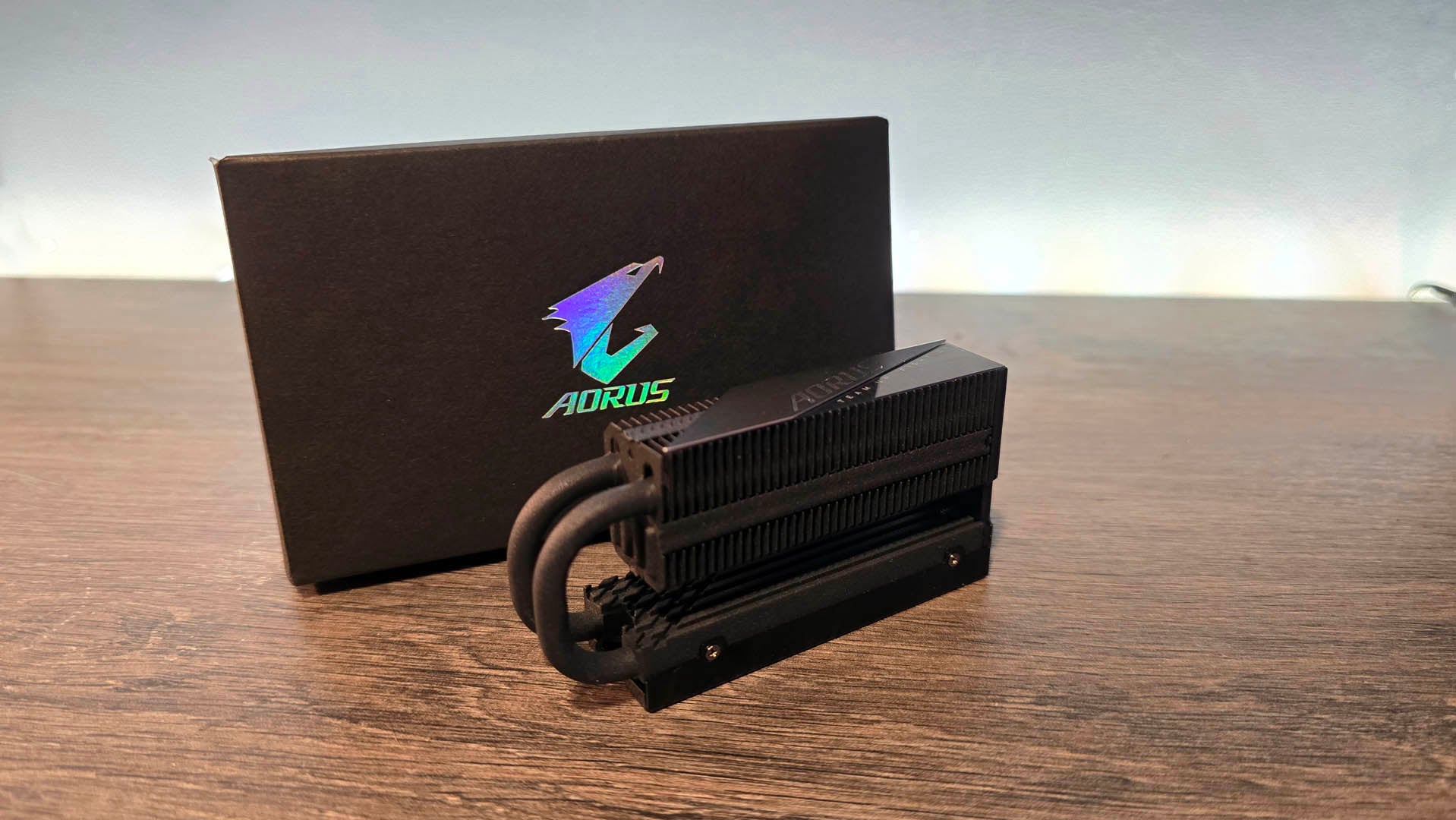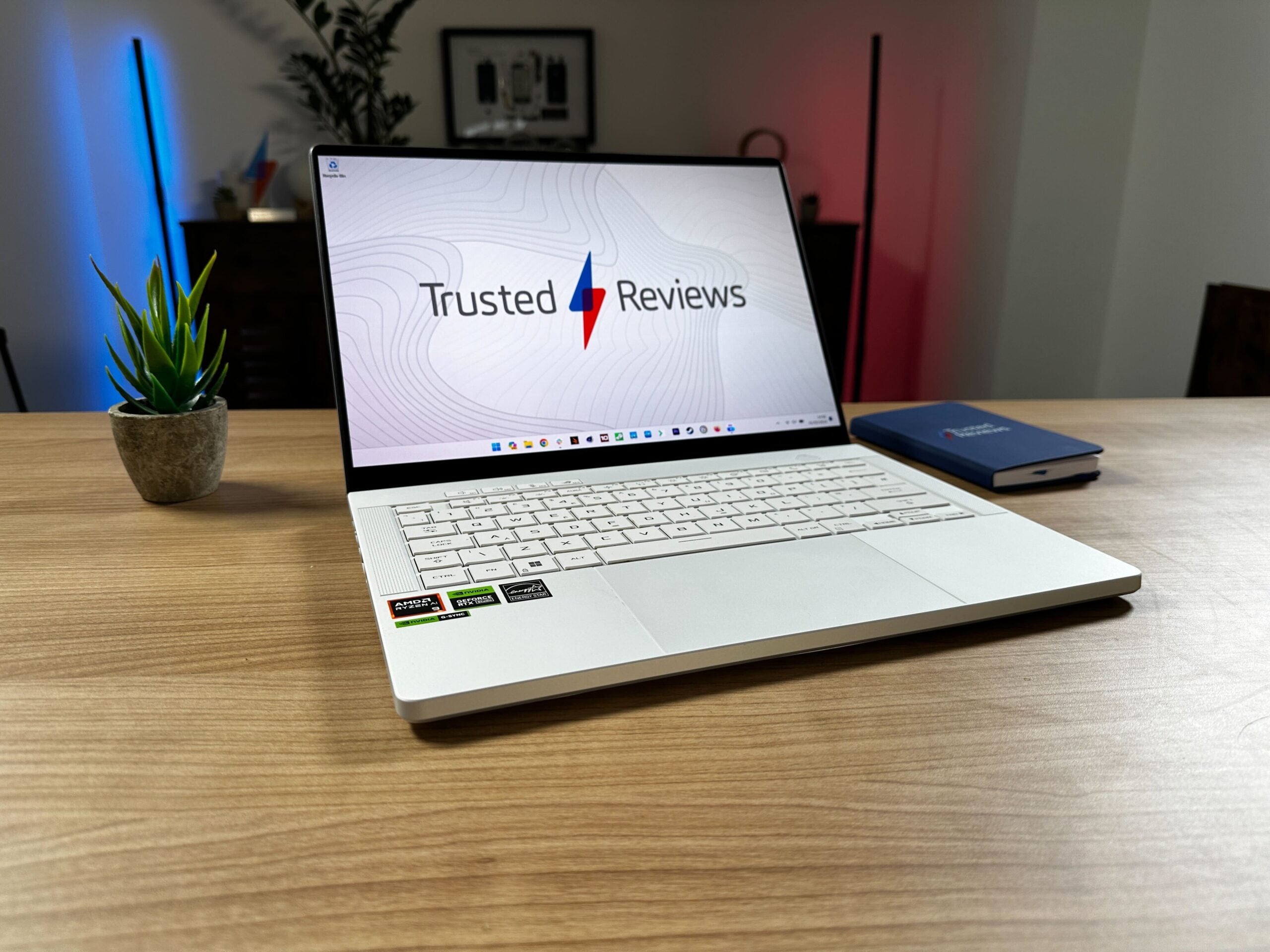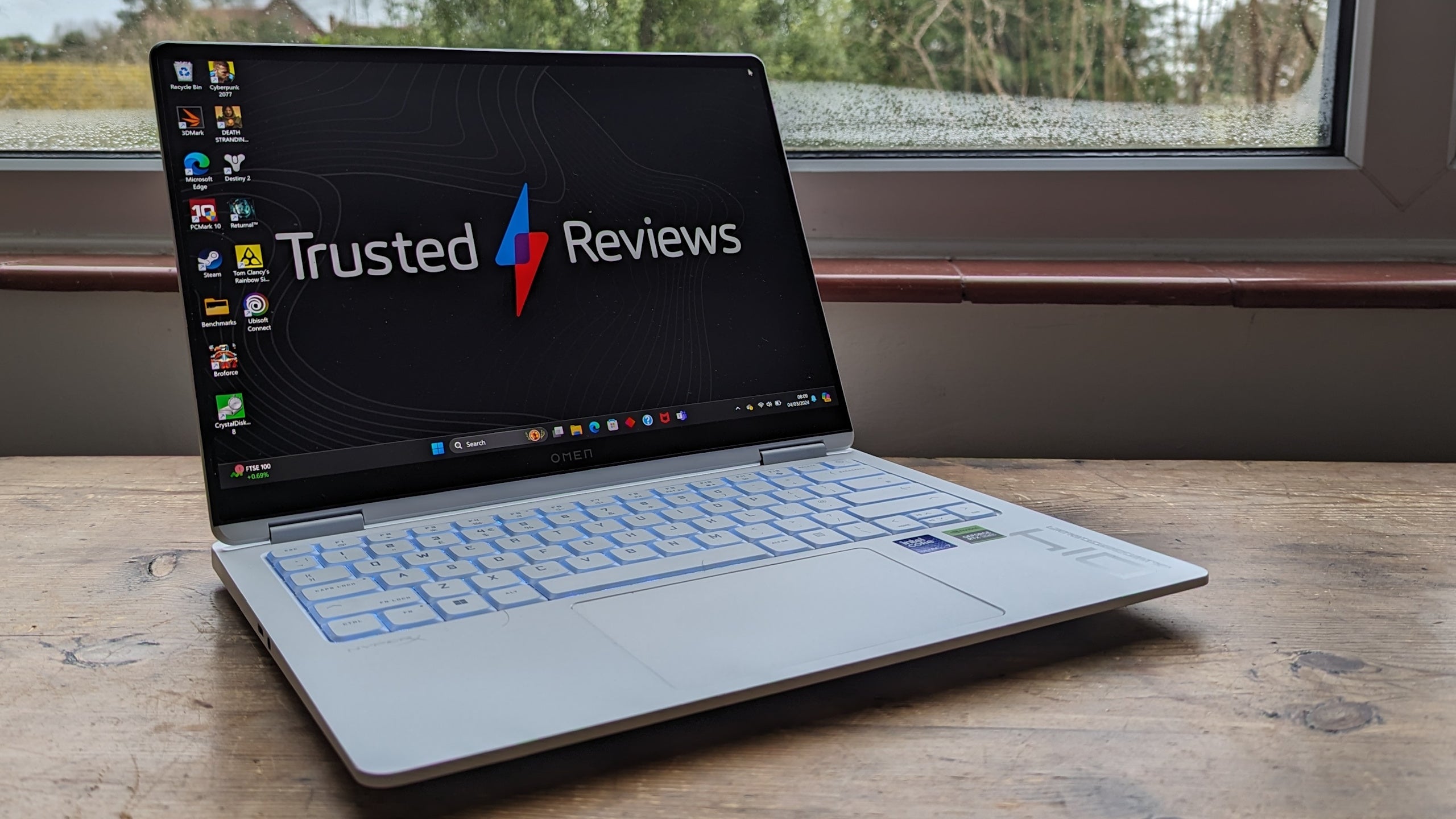Samsung M8 Smart Monitor (2023) Review
A desktop monitor with TV smarts















Verdict
The Samsung M8 Smart Monitor combines the smart features of a modern TV with the form factor of a desktop monitor for one of the most forward-thinking products in its category. The 2023 model introduces a new 27-inch size along with the standard 32-inch, as well as a full-sized HDMI port, but the excellent 4K display remains the exact same as the preceding year.
Pros
- Excellent 4K picture quality
- Now available in 27-inch form
- New inclusion of full-sized HDMI port
- Smart software is genuinely useful
Cons
- Samsung M7 monitor provides better value
- Lack of OLED or Mini LED option
- Low refresh rate rules out serious gaming
Key Features
- Smart TV experiencePowered by Tizen OS, the M8 can run various apps such as Netflix, Disney Plus, BBC iPlayer, Xbox Game Pass and GeForce Now.
- Full-size HDMI port:The 2023 model now suports a full-size HDMI port for enhanced connectivity.
- Available in both 27-inch and 32-inch sizes:Samsung has introduced a smaller 27-inch model to the 2023 edition of the M8 monitor.
Introduction
Samsung is one of the first companies to push smart monitors onto the masses, offering the smarts of a modern TV to provide access to all of your favourite streaming apps without the need for an external device.
I reviewed the Samsung M8 (2022) last year and was really impressed with the high-quality display and bounty of smart features. Jump forward to 2023, and Samsung has updated its monitor with enhanced smart features such as My Contents, as well as a full-size HDMI port, new pivot functionality and the addition of a new 27-inch model along with the standard 32-inch design reviewed here.
Little else has been upgraded, with Samsung refraining from making any tweaks to the 4K screen. That makes it difficult to justify upgrading between models, but which offers the best value for newcomers? After spending a couple of weeks with the Samsung M8 Smart Monitor (2023), here are my thoughts.
Design
- Available in both 27-inch and 32-inch sizes
- Now supports wall mounting and pivoting
- Sports a full-size HDMI port for first time
I’m a big fan of the design of the Samsung M8 Smart Monitor (2023). It looks almost identical to its 2022 predecessor, but it’s difficult to see where else Samsung could have improved.
It flaunts a wafer-thin black bezel that neatly frames the screen, with Samsung adopting a clean, minimalist approach that gives me strong iMac vibes.

While the design is visibly distinguishable from the 2022 model, Samsung has made a couple of minor tweaks. The 2023 version I have for review, with the stand included, is 41mm taller and 3.7mm thinner than its predecessor. That’s not enough to make a noticeable difference, although it does make it slightly heavier to carry around at 7.2kg.
Initial setup is easy peasy, with the stand slotting effortlessly into the screen’s rear. You will need to screw the stand into its base, but the screw is included and only takes a matter of seconds to tighten. Once assembled, the monitor has a secure base, so you shouldn’t need to worry about accidental topples.
Adjusting the height of the monitor (up to 12cm) is as easy as pulling and pushing, while there’s also the option to tilt the monitor forwards and backwards. New to the 2023 model, the Samsung M8 now supports wall mounting (100×100) and can pivot by up to 92 degrees for a portrait alignment – this form is useful for reading long articles online, although most people will likely prefer to keep the monitor horizontally.
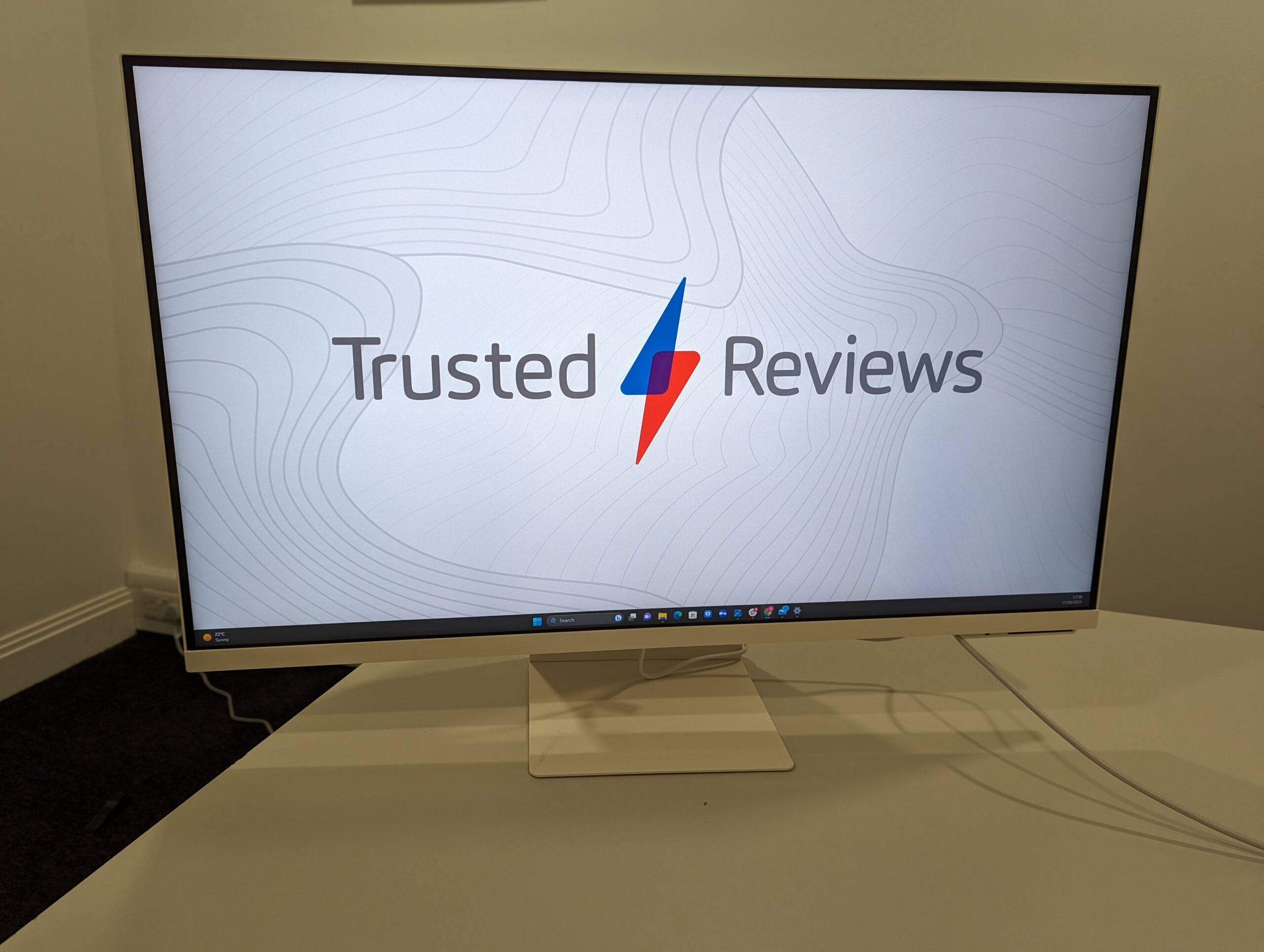

The Samsung M8 Smart Monitor was previously only available with a 32-inch screen, but Samsung has now made it available in a 27-inch form. This makes Samsung’s monitor more accessible to those on a tight budget, with the smaller screen size available for just £599/$649.99, whereas the 32-inch model is priced at £649/$699.99.
Samsung claims the M8 monitor is available in white, pink or green. Sadly, I can only find the white option on Samsung’s official UK website, with a warning that colour options will vary depending on the country. That’s a great shame for Brits, especially when the older 2022 iteration of the monitor is still available with blue, green and pink colourways. Nevertheless, the default white colour is still pleasing to the eye with a patterned finish on the rear.

My personal favourite upgrade for the 2023 model of the Samsung M8 monitor is the introduction of a full-sized HDMI connection, swapping it in for the Micro HDMI port which isn’t as commonly used. Alongside 1x USB-C and 2x USB-A, it’s now substantially easier to connect the monitor to virtually any laptop. The only notable omission is DisplayPort, but that’s not a major issue.
A little white remote comes with the M8, making it easy to navigate the settings and all of the integrated streaming apps. It sports a USB-C port for recharges, although I assume battery life is long as I never needed to recharge the cell during the testing process.
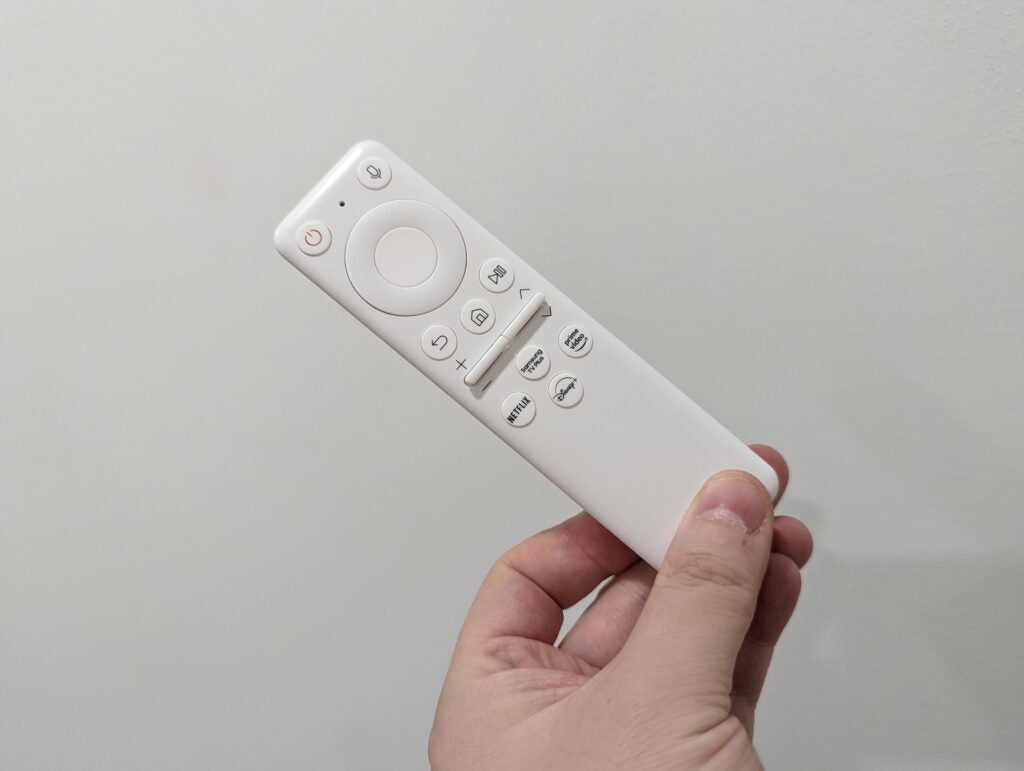
The M8 is also bundled with an external webcam, which magnetically clips to the back of the monitor to allow the camera to peep over the top. I’d personally prefer Samsung to integrate the webcam into the monitor itself, but also understand Samsung’s desire to keep the screen bezel as slender as possible.
Video quality is great with a 1080p resolution, while the webcam can be tilted up and down.


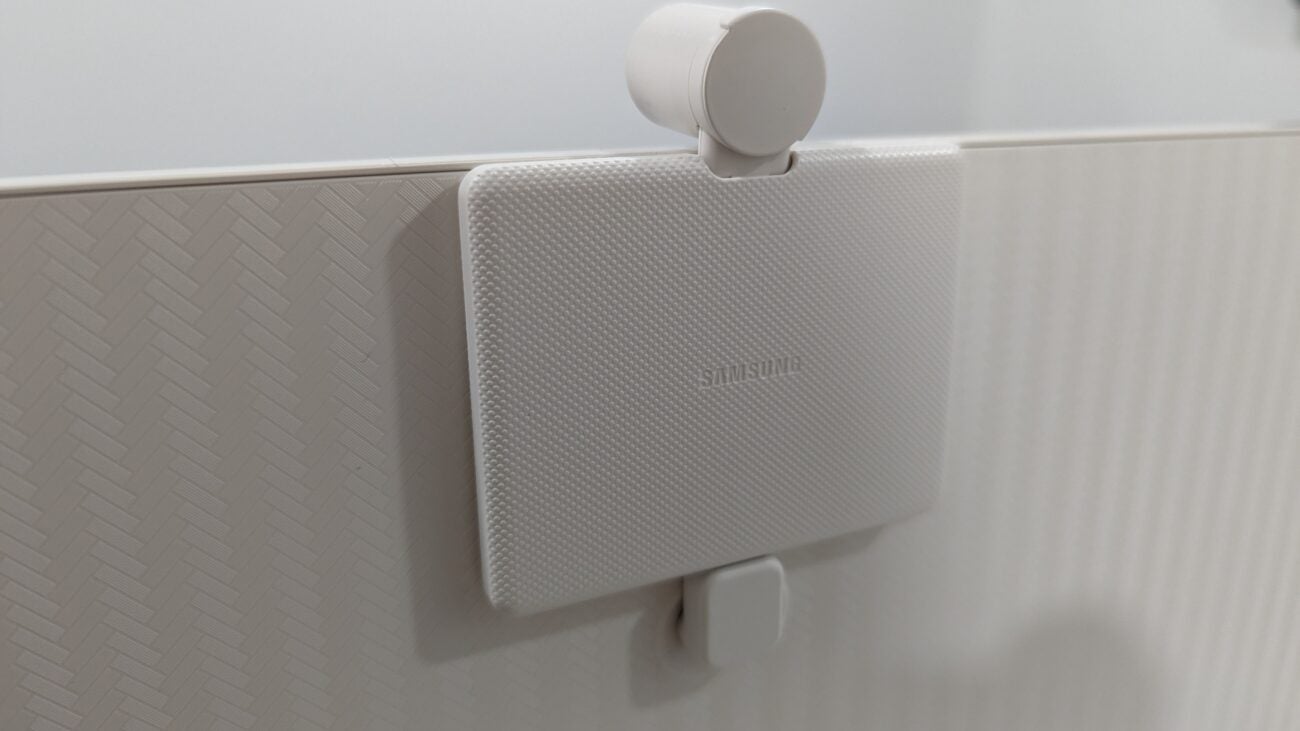
I’m disappointed with Samsung’s efforts when it comes to sustainability. Recycled plastics have not been used for the monitor’s construction, and there’s excessive plastic and polystyrene in the box. The M8 Smart Monitor also has a G rating in the Energy Efficiency Class, which is the worst possible score. This is a big disappointment, especially since Samsung has made such big eco-friendly strides for its smartphones and laptops.
Screen
- Same 4K screen as its predecessor
- Superb contrast and brightness
- Loud integrated speakers
Samsung hasn’t made any changes to the screen for the Samsung M8 Smart Monitor (2023) compared to its 2022 predecessor. That’s disappointing, as it would have been nice to have the option of an OLED or Mini LED panel, or even a higher refresh rate, but this is nonetheless an excellent display.
Both the 27-inch and 32-inch version of the M8 sport a 4K (3840 x 2160) resolution for a pixel-packed picture capable of sharp imagery. Pair this with the bold colours and high brightness, and this is an excellent monitor for both productivity and streaming video.



I used a colorimeter to get exact figures of the monitor’s performance. Samsung claims a peak brightness of 400 nits, but my review model was actually capable of an impressive 450 nits. Either way, the M8 is far brighter than your average monitor.
Out of the box, the M8 recorded a contrast of 3255:1, but by pushing up the brightness I was able to improve the contrast to 4900:1. This is an excellent result, and is likely the main reason why the picture looks so darn good to the naked eye.
Upgrading to an OLED or Mini LED would have improved the picture even further, with Samsung opting for a more bog-standard VA screen instead. But to Samsung’s credit, I recorded a low black level of just 0.09 nits, so it isn’t too far away from displaying perfectly inky blacks like an OLED panel.


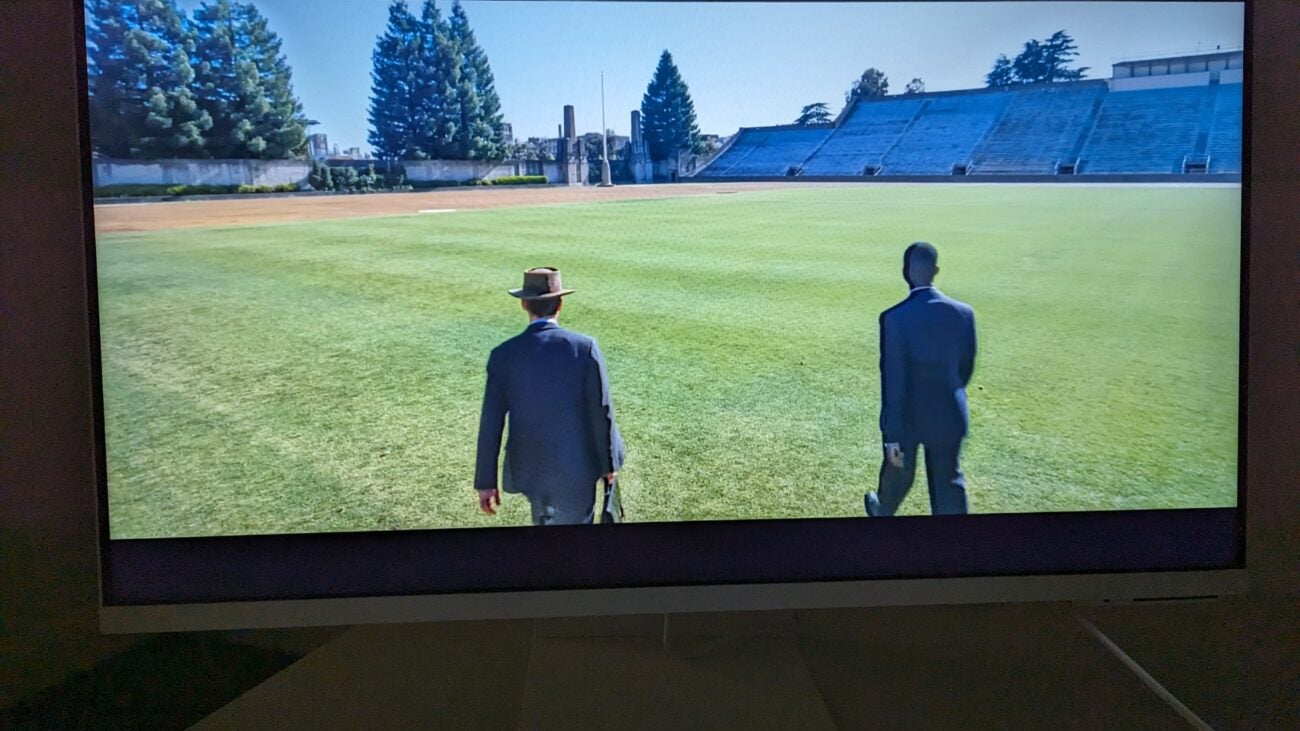
The Samsung M8 isn’t quite so good when it comes to colour coverage, with just 85% and 88% coverage for the Adobe RGB and DCI-P3 profiles respectively. This means you can find better monitors suited to colour-sensitive work for creative professionals, although those scores are still plenty high enough for more casual work.
Serious gamers will want to look elsewhere too, as the refresh rate is limited to 60Hz. You can get higher speeds at half the price, although you will lose out on general picture quality and all the smart software. If you only intend on gaming through the likes of Game Pass, or don’t care about high refresh rates, then the M8 is still perfectly fine to use for gaming.
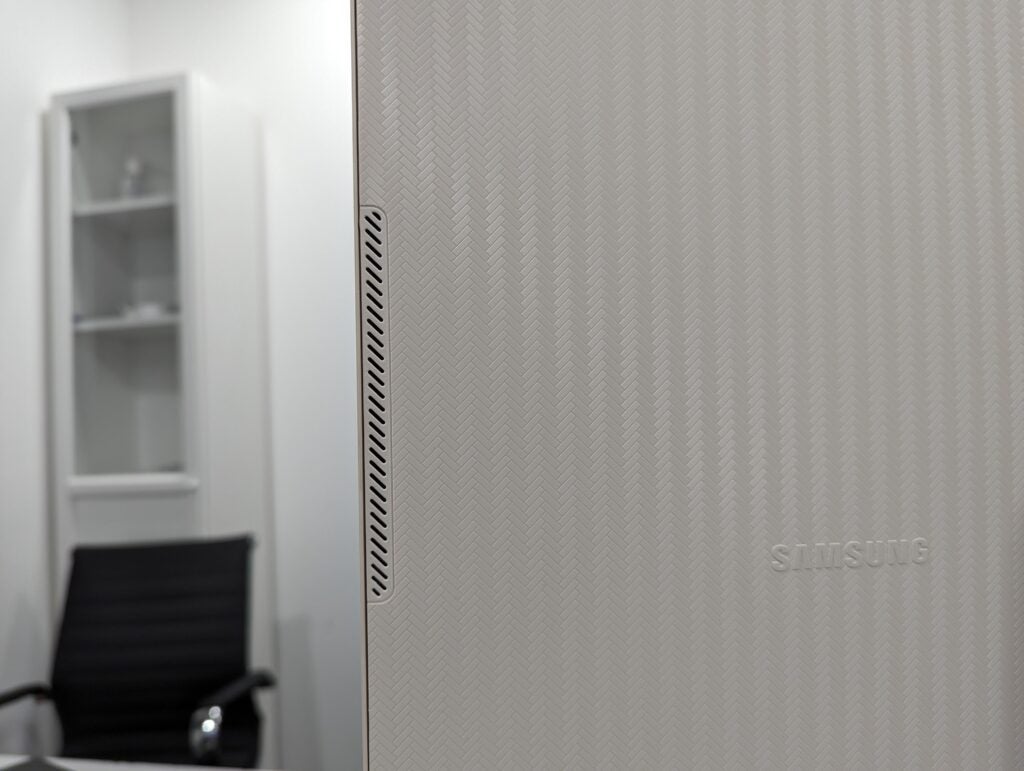
Speakers are built into the monitor, so you don’t need to bother with an external audio system. Volume can be increased to a room-filling decibel. I’ve happily used the monitor’s speakers for Spotify music playback and movie watching.
Software and Features
- Streaming apps installed by default
- Supports voice commands from Alexa and Bixby
- My Contents feature is unremarkable
The unique selling point that makes the Samsung M8 such a compelling purchase is all of the smart software stuffed inside. This is one of few monitors that can operate independently, and so can stream all of your favourite apps without the need of being hooked up to a PC.
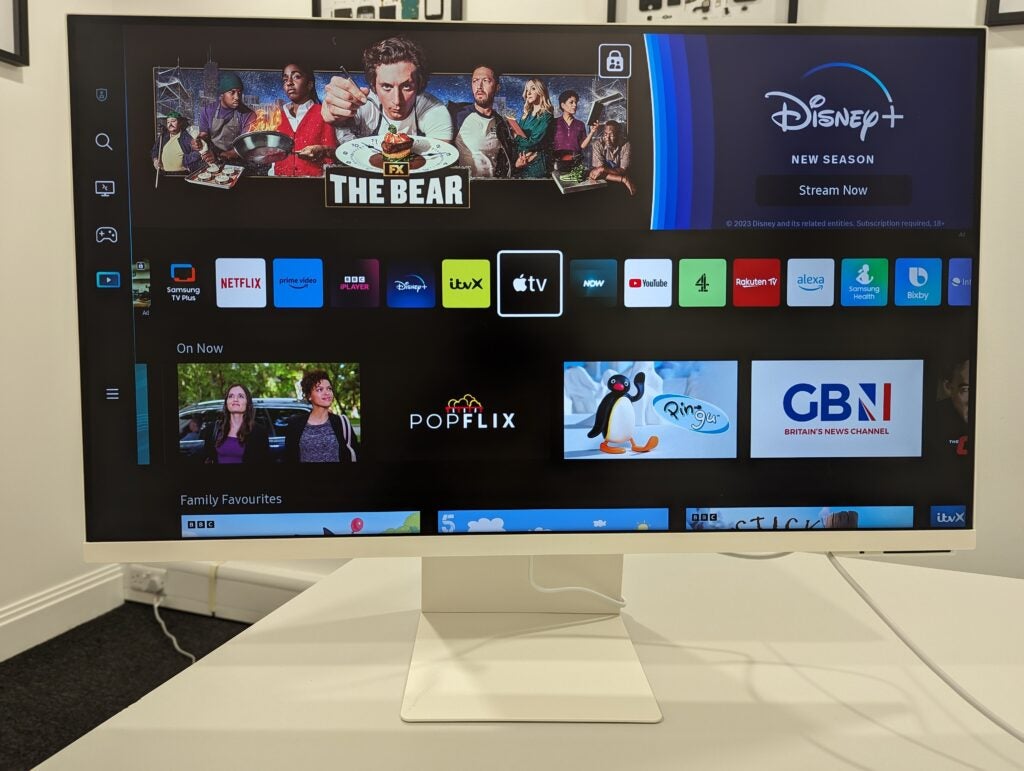
The M8 uses Samsung’s own Tizen operating system, which has an abundance of pre-installed apps and features. It feels very similar to the experience of a modern day smart TV.
Netflix, Disney Plus, Apple TV, Now, YouTube, Prime Video, ITVX and more are all pre-installed on the monitor for easy access. Samsung TV Plus even lets you access a strange mix of bespoke TV channels such as Mythbusters and American Idol.
There’s a dedicated gaming section too, with pre-installed apps for cloud platforms such as Xbox Game Pass, Amazon Luna, Nvidia GeForce Now and Utomik. Simply connect a gaming controller to the monitor via Bluetooth, and sign up to one of these subscriptions, and you’re good to go.
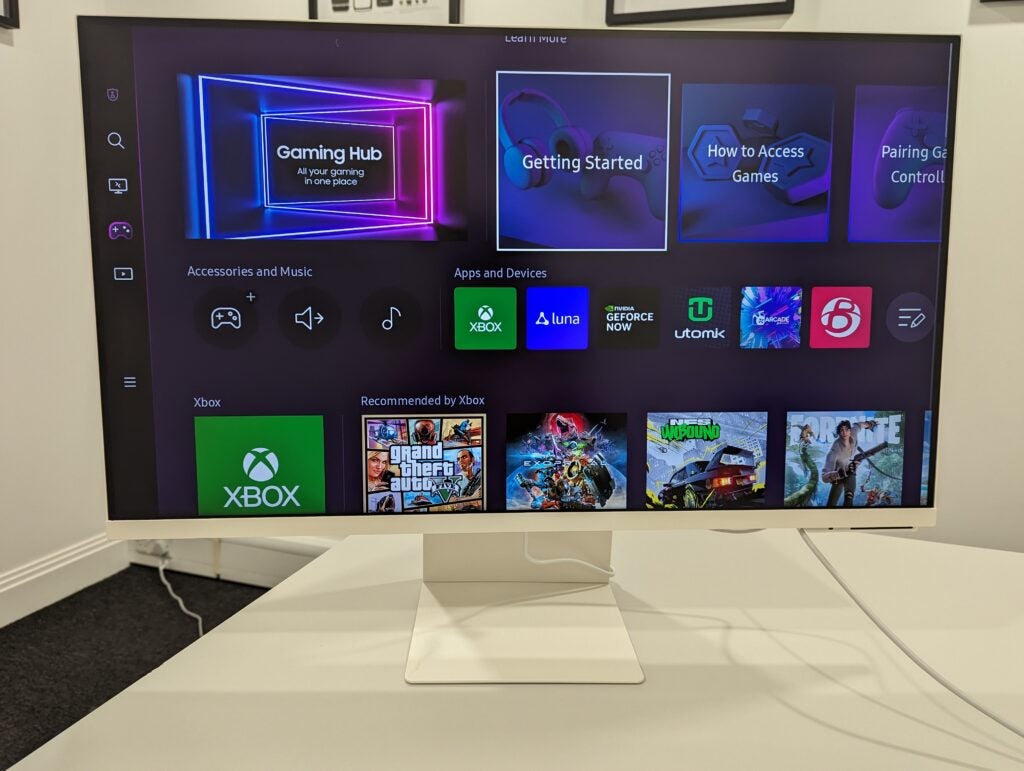
Both Bixby and Amazon Alexa are built into the monitor too, allowing you to use voice commands to navigate through the monitor’s software. It works just as well as you could hope for too.
A brand new feature for the 2023 model includes My Contents. This is a customisable screensaver that will be displayed whenever your smartphone is in proximity of the monitor, falling into standby mode once you move away. You can set your photos and calendar to this screensaver, and even configure it to display a weather report.

However, I found this feature to be a pain to set up, requiring use of the SmartThings app. You seemingly only get full functionality when using a Samsung Galaxy smartphone, and so will likely alienate the majority of its user base.
The Multi View mode has been treated to an upgrade to, finally allowing you to use Microsoft 365 apps and the Browser app in full screen mode. But this feels more like a correction than a new feature to get excited about.
Latest deals
Should you buy it?
You want a productivity monitor with smart skills: The Samsung M8’s best feature is the ability to run streaming apps without the need of an external device. This includes the likes of Netflix and Xbox Game Pass.
You want a gaming monitor: The M8 may be able to run various gaming apps, but its 60Hz refresh rate limits its appeal for playing games through a PS5, Xbox Series X or PC. Check out our Best Gaming Monitor guide instead.
Final Thoughts
The Samsung M8 Smart Monitor (2023) is one of my all-time favourite productivity monitors. It boasts excellent picture quality, while the integrated apps and smart features ensure it’s still useful when your PC isn’t connected.
It’s more of a minor revision than an upgrade on the 2022 edition however. The screen specs haven’t been altered at all, while new features such as My Contents do little to improve the software offering. More handy is the new full-sized HDMI port, as well as the introduction of the smaller and more affordable 27-inch model.
These upgrades aren’t quite enough to prove that the M8 is a better value purchase than the Samsung M7 Smart Monitor, which is noticeably more affordable. Meanwhile, gamers are better off checking out the Samsung Odyssey Neo G7, and creative professionals who own a Mac should consider the Apple Studio Display. For more options, check out our Best Monitor guide.
How we test
We use every monitor we test for at least a week. During that time, we’ll check it for ease of use and put it through its paces by using it for both everyday tasks and extended gaming sessions
We also check its colours and image quality with a colourimeter to test its coverage and the display’s quality.
We used it as our main monitor for at least a week.
We used a colorimeter to get benchmark results.
FAQs
There aren’t a huge number of differences between the monitors. The M8 display is brighter than the M7, and has a more premium and sturdier stand. The M7 also lacks a bundled webcam, forcing you to seek an external solution instead.
Picture quality will look great here with the 4K resolution. However, the 60Hz refresh rate of the monitor means you won’t be able to visibly benefit from the possible 120fps performance for select games.
The 27-inch model of the Samsung M8 has a price of £599/$649.99, whereas the 32-inch model is priced at £649/$699.99.



